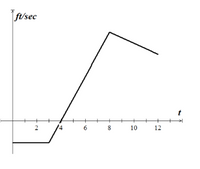
Calculus: Early Transcendentals
8th Edition
ISBN: 9781285741550
Author: James Stewart
Publisher: Cengage Learning
expand_more
expand_more
format_list_bulleted
Question
The graph below shows the velocity of an object moving along a straight line for the time interval of 0 ≤ t ≤ 12.
When does the object slow down?

Transcribed Image Text:fi/sec
6
8
10
12
2.
Expert Solution
This question has been solved!
Explore an expertly crafted, step-by-step solution for a thorough understanding of key concepts.
Step by stepSolved in 2 steps with 1 images

Knowledge Booster
Learn more about
Need a deep-dive on the concept behind this application? Look no further. Learn more about this topic, calculus and related others by exploring similar questions and additional content below.Similar questions
- The velocity graph of a particle moving along a straight line is shown below. The velocity is given in feet per second and the time in seconds and positive velocity indicates the particle is moving to the right. Briefly explain each answer. (a) Find the change in position of the particle over the time interval from 0 to 10 seconds. (b) Find the total distance traveled by the particle of the particle over the time interval from 0 to 10 seconds..arrow_forward#13arrow_forwardPlease show step-by-step solutionarrow_forward
- Can I please get helparrow_forwardA bus leaves a bus stop and accelerates at a constant rate for 10 seconds. During this time, the bus traveled 20 meters. Then the bus traveled at a constant speed for 10 seconds. Then the driver noticed his destination 10 meters ahead and slams on the brakes. Assume the bus decelerates at a constant rate. Eight seconds after the bus left the bus stop, a car passed by the bus stop travelling with constant velocity of 10 meters per second. How long (from the bus stop) will the car meet the bus? Express your answer in "seconds".arrow_forwardAt 1 p.m., snail A is 9 ft west of snail B. Snail A moves north at 2 ft/hr and snail B moves south at 2 ft/hr. How fast is the distance between the snails changing at 4 p.m.? (a) Draw a diagram for this scenario. Create and label each variable. (b) What is known/given? What needs to be found? (c) Use your diagram to determine a function relating the variables in this scenario. (d) Find the appropriate ratearrow_forward
arrow_back_ios
arrow_forward_ios
Recommended textbooks for you
 Calculus: Early TranscendentalsCalculusISBN:9781285741550Author:James StewartPublisher:Cengage Learning
Calculus: Early TranscendentalsCalculusISBN:9781285741550Author:James StewartPublisher:Cengage Learning Thomas' Calculus (14th Edition)CalculusISBN:9780134438986Author:Joel R. Hass, Christopher E. Heil, Maurice D. WeirPublisher:PEARSON
Thomas' Calculus (14th Edition)CalculusISBN:9780134438986Author:Joel R. Hass, Christopher E. Heil, Maurice D. WeirPublisher:PEARSON Calculus: Early Transcendentals (3rd Edition)CalculusISBN:9780134763644Author:William L. Briggs, Lyle Cochran, Bernard Gillett, Eric SchulzPublisher:PEARSON
Calculus: Early Transcendentals (3rd Edition)CalculusISBN:9780134763644Author:William L. Briggs, Lyle Cochran, Bernard Gillett, Eric SchulzPublisher:PEARSON Calculus: Early TranscendentalsCalculusISBN:9781319050740Author:Jon Rogawski, Colin Adams, Robert FranzosaPublisher:W. H. Freeman
Calculus: Early TranscendentalsCalculusISBN:9781319050740Author:Jon Rogawski, Colin Adams, Robert FranzosaPublisher:W. H. Freeman
 Calculus: Early Transcendental FunctionsCalculusISBN:9781337552516Author:Ron Larson, Bruce H. EdwardsPublisher:Cengage Learning
Calculus: Early Transcendental FunctionsCalculusISBN:9781337552516Author:Ron Larson, Bruce H. EdwardsPublisher:Cengage Learning

Calculus: Early Transcendentals
Calculus
ISBN:9781285741550
Author:James Stewart
Publisher:Cengage Learning

Thomas' Calculus (14th Edition)
Calculus
ISBN:9780134438986
Author:Joel R. Hass, Christopher E. Heil, Maurice D. Weir
Publisher:PEARSON

Calculus: Early Transcendentals (3rd Edition)
Calculus
ISBN:9780134763644
Author:William L. Briggs, Lyle Cochran, Bernard Gillett, Eric Schulz
Publisher:PEARSON

Calculus: Early Transcendentals
Calculus
ISBN:9781319050740
Author:Jon Rogawski, Colin Adams, Robert Franzosa
Publisher:W. H. Freeman


Calculus: Early Transcendental Functions
Calculus
ISBN:9781337552516
Author:Ron Larson, Bruce H. Edwards
Publisher:Cengage Learning